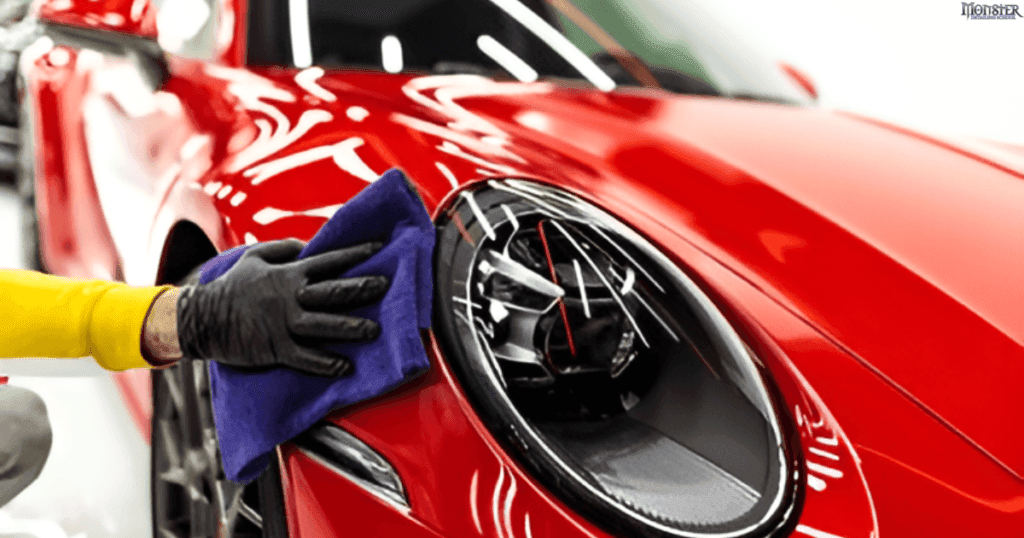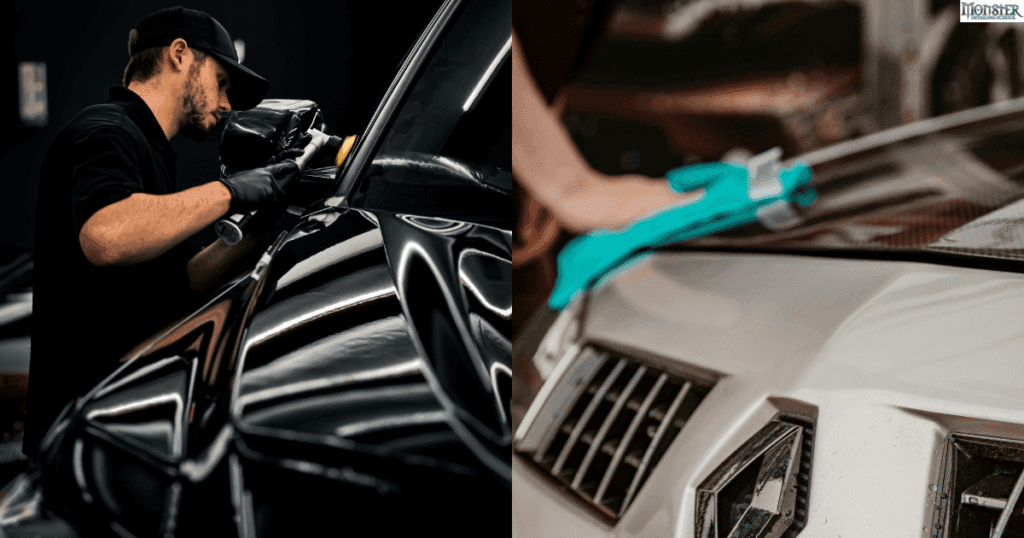The Ultimate Guide to Hand Polishing a Car

At Monster Detailing School, we’re dedicated to providing the best practices and advanced training in car detailing. Our mission is to empower students with the skills and knowledge to become leaders in the industry through comprehensive and multilingual training. This guide will show you how to polish your car by hand, covering everything from compounding to cutting, while keeping it simple for anyone to do at home. Let’s dive in and get your car looking like it just rolled off the showroom floor! Why Choose Hand Polishing? Hand polishing is an ideal option for car enthusiasts who want to take a personal approach to maintaining their vehicle’s appearance. While it does require more effort than machine polishing, it’s perfect for removing minor scratches, swirl marks, and restoring dull paint. It’s also a safer choice for beginners, as it reduces the risk of damaging the paint. Related Topic: How Long Does It Take to Polish a Car? Best Way to Polish a Car by Hand To achieve professional results when polishing by hand, follow these steps: 1. Thoroughly Wash and Dry Your Car Start by washing your car with a quality car shampoo. Make sure to remove all dirt, grime, and debris to prevent scratches during the polishing process. Dry the car with a microfiber towel. 2. Inspect the Paint Examine the paintwork to identify areas with scratches, swirl marks, or oxidation. Knowing the condition of the paint will help you determine the appropriate level of polishing needed. 3. Select the Right Polish Use a medium-cut polish for a balance between removing imperfections and refining the paint. Choose a hand friendly product that can be applied using a foam or microfiber applicator. 4. Apply the Polish with an Applicator Pad Work in small sections, using a foam or microfiber applicator pad to apply the polish in circular motions. Apply even pressure to ensure consistent results across the entire surface. 5. Buff Off the Residue After polishing each section, use a clean microfiber cloth to remove any residue. This will help reveal the improved shine and clarity. 6. Apply a Protective Wax or Sealant Finish off the process with a wax or sealant to protect the polished surface and maintain the shine. Related Topic: Should You Wax a Car After Polishing? Can I Polish a Car by Hand? Absolutely! Hand polishing is not only possible but also effective for minor imperfections and giving your car that extra glow. It’s a great choice for DIY car enthusiasts who prefer a hands-on approach. For more severe paint issues, however, using a machine polisher may deliver quicker and more dramatic results. How to Compound and Polish a Car by Hand Compounding and polishing go hand-in-hand when it comes to restoring a car’s paintwork. Here’s how to do both effectively: Start with a compound if your car has deeper scratches or noticeable oxidation. Compounds are more abrasive than polishes and help remove significant imperfections. Apply the compound using a foam pad and work it into small sections with firm pressure in back-and-forth or circular motions. Use a microfiber towel to remove any remaining compound and move on to the next area. After compounding, switch to a polish to smooth the surface further and bring out the shine. Related Topic: Hand vs. Machine Polishing: Which One Reigns Supreme? How to Cut and Polish a Car by Hand Cutting is a more intensive form of paint correction that removes a thin layer of clear coat to eliminate defects. Follow these steps for a successful cut and polish: If there are significant swirl marks or dullness, use a cutting compound. Apply it with consistent pressure and circular motions. After cutting, refine the finish with a polishing product to smooth the paint and enhance gloss. Use a microfiber cloth to remove polish residue, then apply a wax or sealant for lasting protection. How to Polish a Car by Hand at Home Polishing at home is a satisfying way to maintain your car’s appearance. Here’s a quick guide: Car shampoo, microfiber towels, polish, foam applicator pads, and wax or sealant. Wash the car to remove dirt and avoid scratches. Work on small sections at a time, applying the polish in circular motions. Use a microfiber cloth to reveal the improved paint finish. Finish with a protective layer to preserve the shine. Related Topic: Is Ceramic Coating Better Than Waxing? Why Train with Monster Detailing School? At Monster Detailing, we don’t just show you how to polish a car by hand—we equip you with the skills and techniques needed to become an expert detailer. Our training covers the latest practices and technology, ensuring our students stand out in the detailing industry. With multilingual instruction and sustainable methods, you’ll learn to deliver top quality services effectively. Whether it’s hand polishing or advanced detailing, we prepare you to offer exceptional results to your clients. FAQs 1. Is hand polishing safe for all cars?Yes, hand polishing is generally safe for all types of cars, including classic vehicles. It’s a gentle method that reduces the risk of damage, especially for beginners. 2. How often should I polish my car?Polish your car once or twice a year, depending on the paint’s condition. Frequent polishing can thin the clear coat, so it’s best to do it only when needed. 3. Can hand polishing remove deep scratches?Hand polishing can reduce the appearance of minor scratches and swirl marks. For deeper scratches, a cutting compound or machine polisher may be necessary. 4. Why use wax after polishing?Wax provides a protective layer, sealing in the shine and helping to repel dirt and contaminants. Related topic: Orbital vs. Rotary Polisher: Which is Best for Your Car Detailing Needs? Conclusion Hand polishing a car is more than just a DIY project; it’s a way to keep your vehicle in pristine condition while enjoying the satisfaction of a job well done. At Monster Detailing School, we’re committed to teaching the best practices and the most advanced techniques, equipping you with the knowledge to
Hand vs. Machine Polishing: Which One Reigns Supreme?

When it comes to car detailing, polishing is a crucial step that helps restore your vehicle’s shine and smooth out imperfections. But the big question is: should you polish by hand or use a machine? Both methods have their pros and cons, and each can be suitable for different situations. In this blog, we’ll explore the differences between hand and machine polishing, helping you decide which technique is best for your needs. At Monster Detailing School, we’re committed to offering the best practices and the most advanced technology to our students. Our comprehensive and multilingual training ensures that our students become leaders in the detailing industry, equipped to provide the highest quality services in a sustainable and effective manner. What’s Involved in the Car Polishing Process? Polishing is a process used to enhance the appearance of a car’s paint by removing scratches, swirl marks, oxidation, and other minor imperfections. It involves using a polishing compound, which is applied to the car’s surface to smooth out imperfections and bring back the paint’s gloss. There are two main methods for polishing a car: hand polishing and machine polishing. Let’s break down each technique. Related Blog: How Long Does It Take to Polish a Car? Hand Polishing Hand polishing is done using a cloth or foam applicator pad to apply a polishing compound directly to the car’s paint. It’s a traditional approach that has been used for years and is still preferred by some car enthusiasts. Pros of Hand Polishing 1. Precise Control: Hand polishing gives you complete control over the amount of pressure you apply and the areas you focus on. This is especially helpful for intricate or delicate areas where machine polishing may not reach easily. 2. Gentle on the Paint: Hand polishing is less aggressive than machine polishing, making it a good choice for surfaces with thin or delicate paint. It reduces the risk of accidentally damaging the paint or clear coat. 3. Great for Small Areas: When you need to polish small or tight areas, such as around badges or door handles, hand polishing allows you to target those spots with precision. 4. No Special Equipment Required: Hand polishing only requires basic tools like a microfiber cloth or foam pad, which makes it an accessible option for beginners or those who don’t have access to a machine polisher. Cons of Hand Polishing 1. Time-Consuming: One of the biggest drawbacks of hand polishing is that it takes much longer than using a machine. You’ll need to put in a lot of effort to achieve noticeable results. 2. Inconsistent Results: Since hand polishing relies on your physical effort, it can be difficult to maintain consistent pressure, leading to uneven results. It’s not ideal for tackling deeper scratches or more extensive paint corrections. 3. Less Effective for Heavy Damage: Hand polishing may not be powerful enough to remove deep scratches, heavy swirl marks, or severe oxidation. In these cases, machine polishing is often more effective. Related Blog: How Much Does Car Polishing and Buffing Cost? Machine Polishing Machine polishing uses an electric or battery-powered polisher with a rotating or oscillating pad to apply the polishing compound. This method is popular among professional detailers because it delivers faster and more consistent results. Pros of Machine Polishing 1. Faster Results: Machine polishing is significantly faster than hand polishing, making it suitable for larger surfaces or when you need to complete a detailing job quickly. 2. More Effective for Paint Correction: Machine polishers are powerful tools that can remove deep scratches, swirl marks, and heavy oxidation more effectively than hand polishing. 3. Consistent Pressure: Since the machine does the work, it provides a consistent level of pressure across the surface, leading to more uniform results. 4. Various Pad and Compound Options: Machine polishers come with different types of pads and compounds, allowing you to choose the right combination for your specific needs, from light polishing to heavy paint correction. Cons of Machine Polishing 1. Risk of Paint Damage: Machine polishers are more aggressive than hand polishing, and if used incorrectly, they can damage the paint or clear coat. It’s important to understand how to use the machine properly to avoid this. 2. Expensive Equipment: Quality machine polishers can be expensive, which may not be ideal for those on a tight budget. Additionally, different polishing pads and compounds add to the overall cost. 3. Requires Skill and Practice: Using a machine polisher effectively requires some level of skill and experience. Beginners may need training to avoid mistakes that could harm the paint. Related Blog: Should You Wax a Car After Polishing? Hand vs. Machine Polishing Deciding whether to use hand or machine polishing depends on several factors, including the condition of the car’s paint, the level of correction needed, and your experience with detailing. When to Choose Hand Polishing 1. Minor Imperfections: If your car’s paint has only light scratches or minor swirl marks, hand polishing can effectively restore the shine without needing a machine. 2. Delicate or Thin Paint: Hand polishing is ideal for vehicles with thin paint or delicate finishes, as it’s less likely to cause damage. 3. Small or Hard-to-Reach Areas: Hand polishing is the better choice for tight spots or detailed areas that a machine can’t reach. Read More: How Much to Tip a Car Detailer Conclusion Ultimately, there is no clear winner between hand and machine polishing because the best choice depends on your specific needs. Hand polishing is great for delicate areas and light correction, while machine polishing is the go-to for deeper paint corrections and faster results. For those serious about car detailing training, mastering both techniques will give you the versatility to tackle any job with confidence. At Monster Detailing School, we provide the training you need to become a leader in the industry, using the best practices and cutting-edge technology to achieve stunning results.



